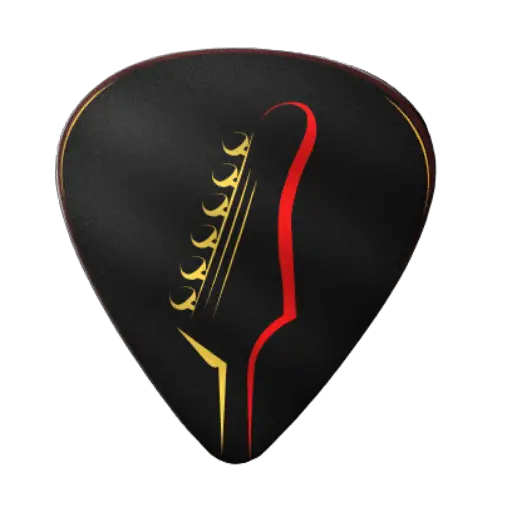Drop C tuning On?
Many guitarists utilize drop C tuning as an alternate, particularly in harder musical genres like metal and hard rock. The lowest string, usually the sixth or low E string, is tuned down two steps from its standard tuning pitch of E to C. In drop C tuning, the six strings of the guitar are tuned to the following notes, starting from the lowest-pitched string to the highest: C, G, C, F, A, and D. While the other strings are set to their regular tuning pitches, the fifth string is also tuned down one complete step from A to G.
Drop C tuning mostly produces a heavier, deeper tone with more low-end power. Guitarists can produce a lower, more aggressive tone without using excessively thick strings by tuning the lowest string down to C. Power chord forms are simpler, and lower guitar registers are easier to access with the drop C tuning. It offers a rich, powerful sound that complements the chugging beats, palm-muted riffs, and furious breakdowns typical of metal and other heavy music.
In addition, guitarists can play melodies and riffs composed expressly for drop C tuning without making many adjustments. Drop C tuning is frequently used by musicians, including well-known groups like Slipknot, Lamb of God, and Kill switch Engage. It is now the go-to tune for individuals who want a louder, more aggressive sound.
It’s crucial to remember that tuning to drop C changes the tension on the strings relative to conventional tuning. The string tension must be slightly increased to preserve appropriate intonation and playability at the lower pitch. It is advised to utilize thicker gauge strings to achieve proper string tension and avoid excessive string buzzing or floppiness when employing drop C tuning.
Guitarists that want to produce a strong and forceful sound frequently choose drop C tuning. A lower pitch and a darker tone are produced by tuning the lowest string down to C. This tuning is especially well suited for the metal and hard rock genres because it makes playing power chords, riffs, and intense breakdowns easier. Drop C tuning has become a common option for achieving a powerful sound without losing playability since guitarists can access various tunes and styles designed expressly for this tuning.
Can An A6 String Be Tuned To Drop The C?

Here is a step-by-step guide on how to tune a typical 6-string guitar in A tuning to Drop C:
Beginning with the lowest note, usually the sixth or low E string, tune it down to C. It must therefore be lowered from E to C by three steps. Use a tuner or a reference pitch to reach the desired C pitch.
The fifth string, typically the A string, must be tuned down two full steps from A to G. The drop-C tuning is maintained while allowing for the necessary spacing between the strings.
Strings 4, 3, 2, and 1
The final four strings, tuned in common tuning to D, G, B, and E, will not alter. These strings won’t change pitch for drop C tuning and will keep their original pitches.
You may properly tune your typical 6-string guitar from A tuning to Drop C by following these instructions, but there are a few things to remember.
String tension
Tuning your guitar in drop C will reduce overall string tension compared to standard tuning. The strings could seem looser and more prone to buzzing or feeling floppy due to the lower tension. It is advised to use heavier-gauge strings, which offer more tension and stability, to combat this. In addition to maintaining good intonation, thicker strings will lessen excessive buzzing or rattling.
Adjustments to setup
Changing the tune of your guitar can impact the neck relief, action (string height), and intonation of the instrument. It’s best to either get your guitar set up by a technician or adjust it yourself if you’re confident doing it. This guarantees the best possible playability and averts difficulties like fret chatter or intonation concerns.
Musical options
Unlike conventional tuning, drop-C tuning offers a wider variety of musical options. It offers a lower and heavier sound for musical styles like metal, hard rock, and alternative rock. Experimenting with power chords, riffs, and lower-register melodies can produce interesting results in this tune.
To tune a typical 6-string guitar in A tuning to Drop C, the 6th string must be lowered from E to C by three full steps, and the 5th string must be lowered from A to G by two full steps. The usual pitches are kept for the remaining strings (4, 3, 2, and 1). When investigating this alternate tuning, it’s crucial to consider string tension, potential setup modifications, and the musical possibilities of drop C tuning.
How Can I Lower The C 6 In My Guitar Tuning?

Here is a step-by-step guide on how to tune a typical 6-string guitar to Drop C:
Preparation
Ensure your instrument is in good shape and set up correctly before beginning the tuning process. Make sure the guitar is in tune using normal tuning, check the neck relief, and, if required, modify the action (string height).
Adjust the tension of the 6th string, typically tuned to E, and then tune the Low E String (the sixth string) to C. Lower the string’s pitch by three full steps to C using a tuner or reference pitch. Reduce the tension by rotating the tuning peg counterclockwise until the required C pitch is reached.
The fifth string, ordinarily tuned to A, should now be tuned to G. Reduce the fifth string’s pitch to G by two full steps. To reach the G pitch again, use a tuner or reference pitch. Lower the string’s pitch by turning the tuning peg in the opposite direction.
Strings 4, 3, 2, and 1 Will Retain Standard Tuning
The final four strings—strings 4, 3, 2, and 1—will continue to be in standard tuning. If your guitar was initially set up correctly, these strings should already be in tune. Use a tuner to correct their pitches if they are out of tune.
You can correctly tune your guitar to Drop C by following these instructions, but it’s important to keep the following in mind as well:
String tension
Dropping the tuning to C will reduce total string tension compared to standard tuning. The strings could seem less tight due to the reduced tension, which could create buzzing or floppiness. Use stronger gauge strings, which offer more tension and stability, to counterbalance this. Thicker strings might be used to preserve perfect intonation and avoid excessive buzzing.
Adjusting your guitar’s tuning may impact its intonation, which is the precision of the pitch along the full length of the fretboard. It’s wise to check the intonation and adjust to achieve good intonation. This procedure entails utilizing a tuner to make minor alterations to each string’s saddle length.
Practice and experimentation
Drop C tuning allows various musical options, especially for more intense genres like metal and hard rock. Explore the special musical qualities of this tuning by experimenting with power chords, strong riffs, and lower-register melodies. Experiment with different chord shapes and playing methods to become comfortable with the new tune and understand its possibilities.
Always pay attention to the tuning of your guitar, pausing to let the strings settle before making minute modifications. Throughout your playing session, check the tuning frequently because strings can get out of tune. Enjoy learning about and composing music in Drop C tuning!
The Ideal Strings For A Drop C 6 String

To preserve the best tension, tone, and playability while tuning your 6-string guitar to Drop C, it’s crucial to consider string gauge and composition. When selecting strings for Drop C tuning, keep the following things in mind:
String Gauge
Compared to regular tuning, bigger gauge strings are typically advised to reach the proper tension for Drop C. Heavier strings are used to preserve perfect intonation and avoid excessive buzzing or floppiness. The following is a typical gauge suggestion for Drop C on a 6-string guitar:
- String number six (C): 0.060″ to 0.064″
- 0.046″ to 0.052″ on the fifth string (G).
- 0.036″ to 0.042″ on the fourth string (C).
- 0.026″ to 0.032″ for the third string (F).
- 0.017″ to 0.020″ for the second string (A).
- 0.013″ to 0.016″ for the first string (D).
Although these gauge ranges offer sufficient tension for Drop C tuning, your playing style and personal preferences may also influence your decision. To discover the tension-playability balance that suits you best, try several gauges.
Composition of the strings
The strings’ material makeup can affect the guitar’s overall tone and feel. In Drop C tuning, nickel-plated and stainless steel are popular alternatives for electric guitar strings. While stainless steel offers brighter, more articulate tones, nickel-plated steel offers a balanced tone with a warmer flavor. Some guitarists favor coated strings to extend string life and keep a constant tone over time.
Brand and String Sets
Several string producers offer sets made especially for Drop C tuning. Popular manufacturers like Ernie Ball, Addario, and Elixir offer string sets for heavier tunings. These setups frequently use a certain string gauge option ideal for Drop C, giving each string an even amount of stress. It is worthwhile to test out various brands and sets to select the ones that best suit your playing style and tonal preferences.
Personal Preference
Ultimately, your playing style and personal preferences will determine which strings you use for Drop C tuning. Some guitarists might prefer a slightly thicker gauge for a heavier feel and tone, while others would choose a slightly lighter gauge for better playability.
Try trying several brands, gauges, and compositions to locate the strings that feel comfortable and give the ideal tone for your playing style.
Remember that string selection is personal; what suits one guitarist may not suit another either. To locate the strings that complement your playing and produce the appropriate tone in Drop C tuning, it’s crucial to experiment with various possibilities and gauge combinations.
Is Drop C 6 A Big One?

Drop C tuning on a six-string guitar is regarded as heavy for several reasons:
Lower Tuning
Drop C tuning entails changing the lowest string’s pitch, normally E, to C. The overall tuning is drastically reduced due to these two full-step reductions, which highlight the lower frequencies and produce a more potent sound; the lower pitch lends a heavier and deeper tone.
Increased Low-End Power
Drop C’s lower tuning gives the guitar’s tone more depth and low-end power. The bottom strings’ stronger resonance produces a heavier and more oppressive tone. The added low-end power makes the music heavier and more impactful, making it suitable for genres like metal, hard rock, and alternative rock.
Chugging Rhythms and Palm Muting
Playing chugging rhythms and palm-muted riffs is easier when using drop C tuning. Executing heavy and powerful rhythm patterns is made comfortable by the lower pitch and looser string tension. As a result, guitarists can produce dynamic rhythmic patterns with low, palm-muted notes that fuel the music’s energy.
Drop C tuning is especially well-suited for playing strong breakdowns, a mainstay of heavy genres. The lower tuning gives the breakdown portions the required depth and weight to be devastating and bone-crushing. Precision palm-muted strikes combined with low, powerful power chords produce a strong, aggressive sound that fits the heavy music aesthetic.
Drop C tuning has become quite popular in various heavy music genres, including metalcore, deathcore, and djent. Well-known bands and guitarists frequently use Drop C tuning in these genres to produce distinctively heavy tones. Drop C tuning is known for being heavy, aggressive, and having a certain auditory style.
Although Drop C tuning is regarded as heavy, it’s crucial to remember that heaviness is a matter of opinion and can depend on various elements, including playing style, amp settings, and the context of the music. Heavy playing styles can be built on a base of drop-C tuning. Still, the heaviness ultimately depends on the guitarist’s use of the tuning in compositions and performances.
What String Gauge Should I Use For Drop C?

To maintain the best tension, tone, and playability when tuning your guitar to Drop C, it’s crucial to consider string gauge—also referred to as string thickness. The right string gauge for Drop C relies on the player’s preferences, playing technique, and guitar configuration. Consider the following while choosing a string gauge for Drop C tuning:
Tension and Feel
Drop-C tuning calls for larger strings than conventional tuning to maintain optimum tension. Higher tension from thicker strings produces a more balanced feel and less string floppiness. This can make music easier to play, especially when using aggressive styles like palm-muted chords and strong riffs.
Tone & Sustain
In Drop C tuning, thicker strings typically produce a richer, heavier tone. They have more bulk, which leads to a deeper low-end response and more string resonance. The overall richness and power of your guitar’s tone are boosted by thicker strings, improving sustain.
The flexibility of the strings
Although thicker strings are better for tension and tone, they might be stiffer and harder to bend. Depending on your preferred playing style and technique, this component is subjective. Although heavier riffing and accurate plucking may be more stable on thicker strings, vibrato and subtle bends may be less responsive. Think about striking a balance that matches your playing style and level of comfort.
Changes to thicker strings may impact your guitar’s setup and intonation. To ensure proper playability and accurate pitch throughout the fretboard while using thicker strings, it may be necessary to make changes to the truss rod, action (string height), and intonation. It’s best to either have your guitar set up by a technician or make the necessary modifications yourself if you have the knowledge.
Commonly advised string gauges for a 6-string guitar’s Drop C include:
- String number six (C): 0.060″ to 0.064″
- 0.046″ to 0.052″ on the fifth string (G).
- 0.036″ to 0.042″ on the fourth string (C).
- 0.026″ to 0.032″ for the third string (F).
- 0.017″ to 0.020″ for the second string (A).
- 0.013″ to 0.016″ for the first string (D).
These gauge ranges offer a place to start when choosing the string thickness for Drop C tuning. Your personal preferences, playing style, and the unique features of your instrument may influence your decision. By experimenting with various gauges within these ranges, you can discover the perfect harmony between tension, tone, and playability that suits your preferences and playing style.
Remember that string gauge is a matter of personal preference; what suits one guitarist may not suit another. To discover the pleasant strings to play, give the required tone, and allow for the best possible playability in Drop C tuning, it is vital to experiment with various alternatives, gauge combinations, and brands.
FAQ’s
What is Drop C tuning?
Drop C tuning is a method of tuning a guitar where the lowest string (typically the sixth string) is tuned down two whole steps from the standard E tuning to a C note. The rest of the strings remain in standard tuning (E, A, D, G, B, E).
Why would someone use Drop C tuning?
Drop C tuning is popular among guitarists who play heavy metal, metalcore, and other similar genres. The lower C tuning provides a heavier and darker sound, making it easier to play power chords and heavy riffs. It allows for lower, more aggressive tones without sacrificing playability.
How do I tune my guitar to Drop C?
To tune your guitar to Drop C, follow these steps: a. Begin with your guitar in standard tuning. b. Tune the low E string (6th string) down two whole steps to C. c. Leave the other strings (A, D, G, B, E) in standard tuning.
Can I use regular gauge strings for Drop C tuning?
While you can use regular gauge strings for Drop C tuning, it’s generally recommended to use heavier gauge strings to maintain proper tension. Heavier strings are less likely to feel floppy or produce unwanted buzzes when tuned down to C. Consider using a set of strings specifically designed for drop tunings or selecting a heavier gauge set.
Do I need to adjust my guitar’s truss rod for Drop C tuning?
Changing the tuning of your guitar can affect its neck relief, which is the slight bow in the neck. In some cases, you may need to adjust the truss rod to compensate for the different tension caused by Drop C tuning. If you notice significant issues with string buzz or the guitar’s playability after tuning to Drop C, it’s advisable to consult a professional guitar technician.
Are there any specific techniques or songs associated with Drop C tuning?
Drop C tuning is often associated with heavy and aggressive playing styles. Many metal and hard rock songs use this tuning to create powerful riffs and intense soundscapes. Some notable songs in Drop C include “Chop Suey!” by System of a Down, “Down with the Sickness” by Disturbed, and “In Waves” by Trivium.













